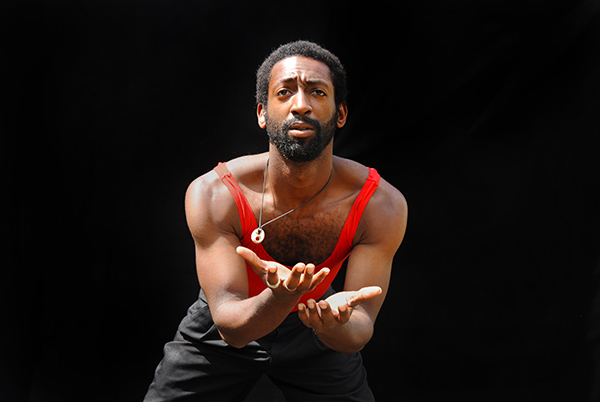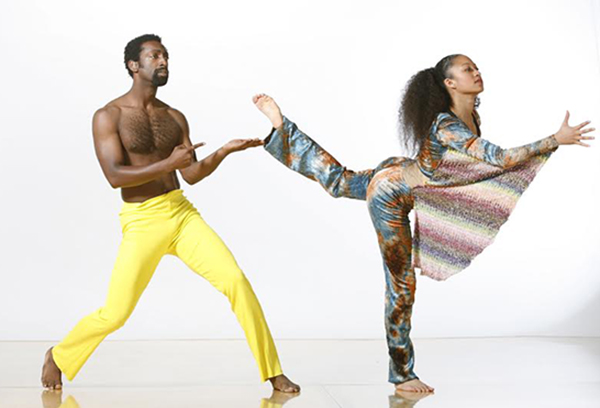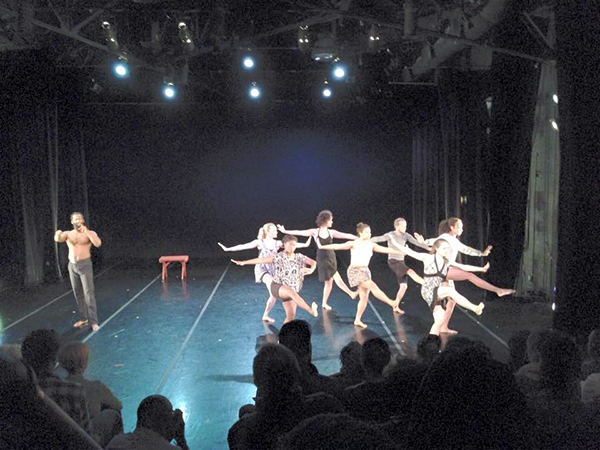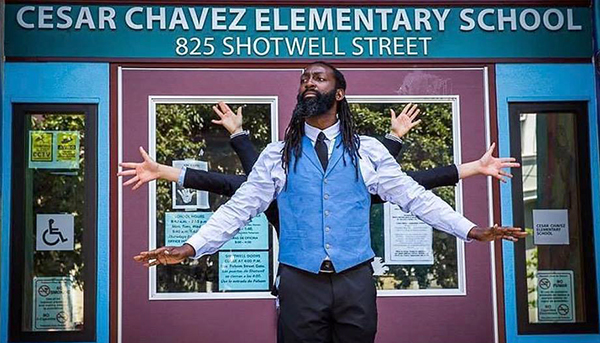Dancing Deaf
An Interview with Antoine Hunter
BY EMMALY WIEDERHOLT
Antoine Hunter is an African American Deaf dance artist based in the Bay Area. The founder and artistic director of Urban Jazz Dance, he has performed throughout the Bay Area and internationally. In 2013, he initiated the Bay Area International Deaf Dance Festival, the first of its kind. He discusses the festival and his work, as well as the unique challenges Deaf dance artists face.
Photo by Richard Dowing
~~
What was your introduction to dance? Was there a specific teacher or mentor who opened doors for you?
My love of dance started by watching the Oakland Ballet’s Nutcracker. Being Deaf, when I would watch TV or go to the movies, I couldn’t connect with what I was seeing even though I was watching the same event as everyone around me. I would miss all the jokes. When I saw the Oakland Ballet, it was wonderful. No one was talking onstage; instead, everyone was dancing as a way to communicate. It showed me that I can use art and dance to communicate with the world.
However, my mom couldn’t afford to take me to dance lessons, so I had to wait until high school. My high school dance teacher taught modern and jazz, and had a lot of energy and fire. Whenever she danced, it always came with passion. She made me want to dance like that too. She didn’t treat me differently even though I was the only Deaf student in her class. She didn’t make me feel like an outcast. She urged me to audition for the California Institute of the Arts, and I got in and went.
What are some common stereotypes you often come across about Deaf people being able to dance?
Times are changing, and people are beginning to see that Deaf people can dance. But I do remember that people used to say Deaf people couldn’t dance. People would say, “They need to hear the music.” The reality is: we all have hearts. We all have feelings. Art is expression. Music is art. If someone has something to express, we’re going to feel it.
I do feel the vibrations sometimes, but if I’m jumping, I can’t feel them. That’s another stereotype, that we can feel the vibrations. Yes, it’s true we can sometimes feel the vibrations, but if I’m doing a double pirouette, a jump or a roll, I don’t feel any vibrations. I have to create my own internal music to stay with the timing, and it’s not an easy thing to do. It takes practice and confidence.
Another stereotype people have is that they assume Deaf people can read lips. If you’re trying to read lips, “m” and “b” look very similar, for example. It’s easy to misunderstand; it’s 95 percent guessing.
What is Urban Jazz?
I started Urban Jazz 10 years ago. It’s about expressing truths. There are a lot of people out there who don’t have opportunities to express themselves. And if you can’t express yourself, you lose your mind. We use many forms: ballet, jazz, African, hip hop. Many of my dancers are Deaf, though some are hearing as well. We tend to perform to jazz music. For me as a Deaf person, trying to use songs with lyrics can be really challenging, but I love jazz music.
We work to make sure that things that are hard to talk about are presented through dance. We don’t just dance for entertainment. We also address social justice issues. Right now, some of my work is about being Deaf in prison. People don’t want to talk about people in prison. But if you’re Deaf and arrested, you might not have access to an interpreter to find out exactly what you’re accused of. In prison, hearing people often have access to telephones, but this isn’t the case if you’re Deaf. Also, prison guards don’t understand how to communicate with Deaf prisoners, and subsequently punish them for insubordination. It’s not an easy thing to talk about, but society needs to know what’s going on. A lot of our work is education.
How did you start the Bay Area International Deaf Dance Festival and how has it grown over the past five years?
I basically just tried to create a platform for Deaf people all over the world. Deaf dance artists have come from Germany, Russia, Australia, Columbia, Hong Kong, Mexico – they all say it’s a miracle experience to work with a Deaf director who knows how to give them what they need and who appreciates their work. A lot of time, Deaf dance artists don’t get what they need. For example, some people who have come to the festival talk about how they’ve had to dance on carpet, which is not ideal for a Deaf dancer. Sometimes they’ve been in situations where the lighting designer decides what to do without their direction. It can be really frustrating. When they get here, they’re so inspired to work with a director who understands. They feel welcome and safe.
The festival has grown every year. This past year, we had 53 artists. They came from all over the world, and they brought their own culture and sign language. Many people think American Sign Language is universal, but it’s not. I hire a sign language interpreter who knows several languages. You have to learn different sign languages the same way you learn, for example, Spanish – by practicing and asking what the sign is for different words.
Our audiences are a mix of hearing and Deaf people. I’ve seen hearing parents with Deaf children, and Deaf parents with hearing children. It’s a great family show. Under the seats, we install a woofer that puts out a huge vibration. It’s very abnormal for hearing people to feel vibrations, but every song that plays, you can feel it. However, we don’t turn up the music too loud. We have another special speaker with a woofer for the performers so they can feel the vibrations while they’re dancing. This is because Deaf people have different levels of deafness. I am completely Deaf. However, some can hear the birds but not the motorcycles, and vice versa.
Is acceptance and understanding of the Deaf community improving over time?
It’s definitely improving. At first, I felt really lonely; I was the only Deaf dancer around. Now, when I go to a dance studio like Shawl-Anderson in Berkeley, people at the front desk say, “Good morning,” and “Don’t forget to sign in” in sign language. People in general are more willing to write things down and communicate. When I create workshops and festivals for Deaf dancers, people show up from around the world.
I do feel like the Deaf dance festival has made a huge impact, especially in the Bay Area. And after the artists leave, they want to create similar events in their own countries. I’ve helped start events in Turkey, Columbia and, soon, Brazil. Next year I’m going to work with Deaf dancers in Africa.
If I see other Deaf people doing their art, I can learn from them. If they grow, I grow. My community is growing.
How would you like to expand your work in the future?
Right now, as an African American Deaf dancer, it’s important for me to represent people of color. A lot of schools don’t have opportunities to bring in role models. I travel to different schools and educate students about Deaf culture by creating a dance series for them to enjoy and learn from. However, a lot of schools can’t afford me, and I need to eat, and it takes money to travel. If I had more funds, I would travel to more low-income schools. That’s where my heart is, and I feel like it’s my responsibility.
Photo by Marco Sanchez
~~
Antoine would like to thank his mom, Zula Hunter, Racha Lawler, Zahna Simon, the Bay Area and everyone who believes in him. To learn more, visit www.realurbanjazzdance.com.




